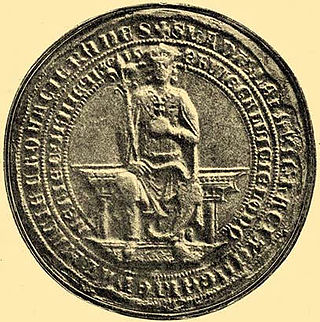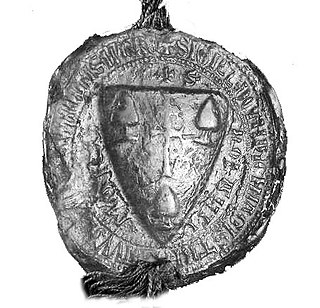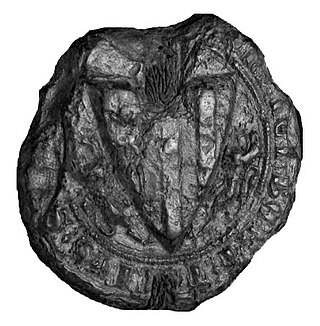Related Research Articles

Ladislaus IV, also known as Ladislaus the Cuman, was King of Hungary and Croatia from 1272 to 1290. His mother, Elizabeth, was the daughter of a chieftain from the pagan Cumans who had settled in Hungary. At the age of seven, he married Elisabeth, a daughter of King Charles I of Sicily. Ladislaus was only 9 when a rebellious lord, Joachim Gutkeled, kidnapped and imprisoned him.
Nicholas from the kindred Geregye was a Hungarian baron and landowner, member of the gens Geregye, who held several positions.

Ivan Kőszegi was an influential lord in the Kingdom of Hungary at the turn of the 13th and 14th centuries. Earlier historiographical works also refer to him Ivan Németújvári. He was Palatine in 1281, between 1287 and 1288, and from 1302 until 1307, Ban of Slavonia in 1275, from 1284 until 1285 and in 1290, and Master of the treasury in 1276 and 1291.
Joachim from the kindred Gutkeled was a Hungarian influential lord in the second half of the 13th century. As a key figure of the struggles for power between the powerful barons in the 1270s, he kidnapped Ladislaus, the son of and heir to Stephen V of Hungary in June 1272, which was an unprecedented case in Hungarian history during that time and marked the beginning of half a century of turbulent period, called "feudal anarchy". Joachim was one of the first provincial lords, who sought to establish an oligarchic domain independently of the royal power. He was killed in a skirmish against the Babonići.

Roland (I) from the kindred Rátót was a Hungarian influential lord, who held several important secular positions for decades. He was also the ancestor of the Paksi family.

Henry (I) Kőszegi from the kindred Héder, commonly known as Henry the Great, was a Hungarian influential lord in the second half of the 13th century who was the founder and first member of the powerful Kőszegi family. Henry was one of the most notable earlier "oligarchs" who ruled de facto independently their dominion during the era of feudal anarchy.
Egidius (II) from the kindred Monoszló was a Hungarian powerful baron, who served as Master of the treasury from 1270 to 1272 and from 1274 to 1275. He was a loyal supporter of Stephen V of Hungary from his ducal years.
Gregory (III) from the kindred Monoszló was a Hungarian lord, who served as the first known Judge of the Cumans in 1269. Through his marriage, he was a relative of the royal Árpád dynasty.
Nicholas (III) from the kindred Hahót was a Hungarian noble and landowner, whose rebellion against the newly crowned Stephen V of Hungary in 1270 was a dress rehearsal for the era of feudal anarchy lasted until the 1320s, and also caused the 1271 war between Hungary and Bohemia.
Timothy was a prelate in the 13th century, who served as Bishop of Zagreb from 1263 until his death.
Denis from the kindred Péc was a Hungarian baron and soldier in the 13th century. Initially, he was a confidant of rex iunior Stephen, but later joined the partisans of the elderly Béla IV of Hungary. He actively participated in the military campaigns against Austria and Bohemia. He served as Palatine of Hungary and other high-ranking positions several times during the era of feudal anarchy.
Nicholas (I) Kőszegi was a Hungarian influential lord in the second half of the 13th century. He was a member of the powerful Kőszegi family. He served as Palatine of Hungary at various times between 1275 and 1298. He was also Ban of Slavonia twice. Albeit he participated in several rebellions against the royal power, he proved to be more moderate and conformist than his younger brothers. He swore loyalty to Andrew III of Hungary after their failed rebellion in 1292. In comparison to the other branches of the Kőszegi family, Nicholas' branch remained relatively insignificant, as he did not establish an oligarchic province independently of the king, unlike his brothers. Nicholas was ancestor of the Rohonci family, which flourished until the mid-15th century.
Lawrence (I) from the kindred Aba was a Hungarian influential baron and soldier in the 13th century, who was considered a loyal supporter of Béla IV of Hungary. He served as Master of the stewards from 1259 to 1270.
Job Csicseri was a Hungarian nobleman and soldier at the turn of the 13th and 14th centuries.
Sebastian, son of Bensa was a Hungarian nobleman and soldier in the second half of the 13th century, who served as ispán of Torna County in 1274.
Panyit from the kindred Miskolc was a Hungarian lord and military leader in the 13th century, a faithful confidant of Stephen V of Hungary. He served as Ban of Severin in 1270.
Lawrence, son of Kemény was a Hungarian influential lord and military leader in the 13th century, who held various positions in the royal court since the late 1250s. He was a skilled and loyal soldier during the reign of Béla IV of Hungary. He retained his influence in the courts of Stephen V and Ladislaus IV too, representing a stable point in the government, when two baronial groups fought for the supreme power. Through his sons, he was ancestor of the Cseményi and Matucsinai noble families.
Dominic from the kindred Csák was a Hungarian lord in the 13th century. Initially, he was a confidant of rex iunior Stephen, but later joined the partisans of the elderly Béla IV of Hungary. During the era of feudal anarchy, he served as a courtier of Queen Dowager Elizabeth the Cuman.
Thomas was a Hungarian prelate in the 13th century, who served as Bishop of Vác from 1278 until his assassination. Simultaneously, he served in the royal court in various positions. He was a faithful confidant of King Ladislaus IV of Hungary.
Peter (II) from the kindred Tétény was a Hungarian baron in the second half of the 13th century, who served as Ban of Slavonia three times. He was a faithful confidant of King Ladislaus IV of Hungary in his fight against the oligarchic domains. Peter was forefather of the Pekri noble family.
References
- 1 2 Zsoldos 2011, p. 261.
- 1 2 3 Kádár 2013, p. 534.
- ↑ Szűcs 2002, p. 215.
- 1 2 Kádár 2013, p. 528.
- ↑ Szűcs 2002, p. 216.
- ↑ Szűcs 2002, p. 390.
- 1 2 Kádár 2013, p. 535.